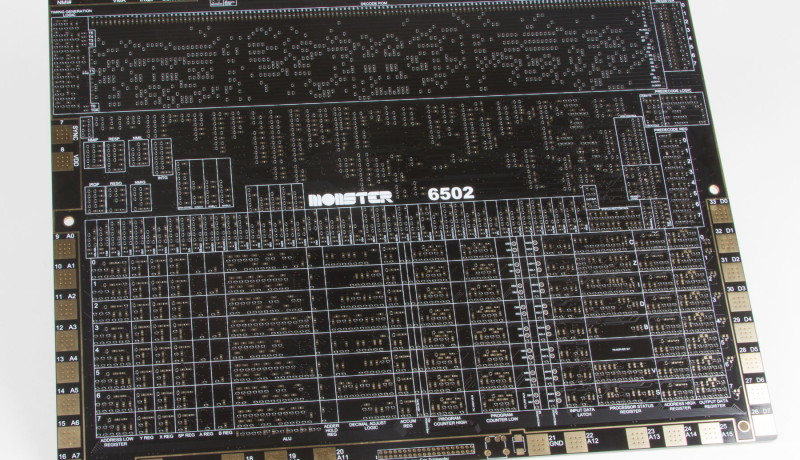Frankenstein’ed: The MOnSter 6502
May 30, 2016
on
on

Eric Schlaepfer in collaboration with Evil Mad Scientist Laboratories’ latest ultra-daft project is a dis-integrated circuit. Dis yes, like in ‘dis’assembly. It’s a complete, working transistor-scale replica of the classic 6502 microprocessor, you know, the one in the early Apple ][ computers, the Commodore PET, the Atari 400 and 800 home video game consoles, the BBC Micro and of course Elektor’s greatest embedded system of all times, the Junior Computer. Even today, entering the sequence ‘6-5-0-2’ on a doorlock in Silicon Valley has a good chance of success.
The MOnSter 6502 is Big. It's a four layer circuit board, 12 × 15 inches, 0.1 inches thick, with surface mount components on both sides. There are 3218 transistors and 1019 resistors that comprise the "functional" part of the 6502. Plus LEDs sprinkled throughout that indicate the values of various control lines, registers, and status bits, as well as additional transistors and resistors (not counted in those "functional" totals) that are necessary to drive those LEDs.
The MOnSter 6502 is Slow. Maximum reliable clock rate is not yet determined, but EMS Labs and Eric expect it to be in the tens to hundreds of kilohertz range. No retailing, no kits… these guys are nuts!
Anyone on the use of capitals in the product name?
The MOnSter 6502 is Big. It's a four layer circuit board, 12 × 15 inches, 0.1 inches thick, with surface mount components on both sides. There are 3218 transistors and 1019 resistors that comprise the "functional" part of the 6502. Plus LEDs sprinkled throughout that indicate the values of various control lines, registers, and status bits, as well as additional transistors and resistors (not counted in those "functional" totals) that are necessary to drive those LEDs.
The MOnSter 6502 is Slow. Maximum reliable clock rate is not yet determined, but EMS Labs and Eric expect it to be in the tens to hundreds of kilohertz range. No retailing, no kits… these guys are nuts!
Anyone on the use of capitals in the product name?
Read full article
Hide full article



Discussion (5 comments)
mfc 8 years ago
Tony White 8 years ago
The manufacturer:
MOS Technology
Will Groves 8 years ago
File under just saying....
Ultimately I used the Atari's 6502 to cut my teeth on ASM programming and prepare for a carrer in embeedded sys development. So cool now that this & more (including peripheral development) is readily available with a low cost FPGA kit and free tools.
TheEditor 8 years ago
Carl Calderon 8 years ago
Throw away garbage that in the making process creates more pollution and wastes energy .
Whay is that people never learn .Is not a complicated fact!